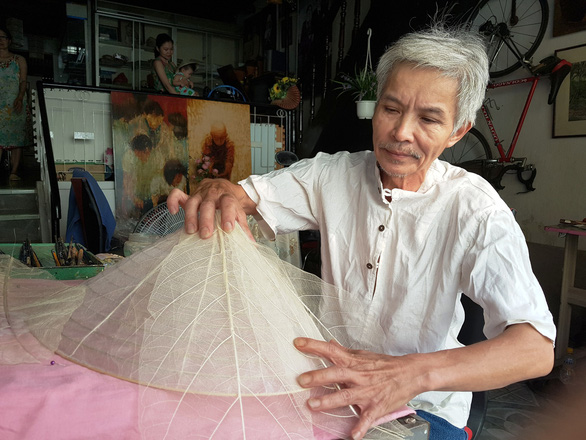A Vietnamese man has put a new twist on the traditional conical hat non la as he replaces the conventional material of palm leaves with almond leaves, giving his hats a crisp and fragile-looking appearance.
Vietnamese conical hats, literally meaning 'leaf hats,' have for long been a symbol of the country as many ladies use them to shelter from the sun.
While the original materials are palm leaves or leaves with similar texture that can make a strong-looking appearance and durability, Vo Ngoc Hung modernizes his products by using transparent almond leaves.
Living in the former imperial capital city of Hue, Hung has been making a living through different forms of art that require utmost meticulousness, including painting, sculpting, and making non la.
“I have been painting on wood, but no one was buying my products,” Hung said.
“I had to find something new, unique, and strange, but still symbolizing Hue,” he added.
|
|
| Vo Ngoc Hung uses a toothbrush to lightly scratch off the green layer of an almond leaf after it has been chemically treated. Photo: An Nhien / Tuoi Tre |
Around a year ago, Hung saw a documentary about the iconic conical hat, which made him think about other materials he can use to modernize the traditional accessory to catch customers' attention.
“I went on the Internet to look for videos teaching how to prepare the leaves,” Hung recalled his self-learning process.
“I tried many different types of leaves including bodhi leaves, fig leaves, and breadfruit tree leaves."
Every time his experiment failed, his wife Le Thi Ky Ngo would encourage him to give it another go, while also looking for other sources of income.
“There was a period when we ran out of money, so we had to sell two of our racing bicycles for VND30 million [US$1,300] so he could keep experimenting,” Ngo said.
One of Hung's friends then suggested he try almond tree leaves but those that grow in the forest, around 30 kilometers from Hue City.
After reaching the forest, the man had to walk another hour before being able to collect the leaves needed to make non la.
This time he succeeded as the previous experiments had taught him the most basic requirements for the leaves to make a conical hat, leading to him collecting the right plants.
|
|
| Vo Ngoc Hung places already treated almond leaves onto a conical hat frame. Photo: An Nhien / Tuoi Tre |
After being chemically treated, the green layer fades, allowing Hung to lightly scratch it off completely leaving the leaves colorless with the leaf veins and petiole showing before putting them in a pressing machine.
Then, the almond leaves are placed one by one on the conical hat’s frame, with each hat being made of 15 to 16 leaves.
For the final procedure, sewing the leaves to the frame, Hung hires others with better expertise in the region to help him.
“I am happy enough to cry,” Hung said after selling the first 60 hats at VND 450,000 ($19) apiece.
“I cannot believe that all the efforts of the past year were finally welcomed by customers and the market.”
Nowadays, 'Non La Hung' makes are in high demand, with many being sold right after production.
Many customers were even fascinated enough to ask to give it a try, but many realized the process of making the hat is highly intricate.
As for Hung, he is currently looking for a way to teach this profession to others while also experimenting with other leaves suitable to make a decoration on his almond leaf conical hats.
“I am trying putting images of Hue’s heritage on the hats,” he said as he was packing the hats in boxes to send to other cities and provinces in Vietnam.
|
|
| Almond leaf non la. Photo: An Nhien / Tuoi Tre |
Like us on Facebook or follow us on Twitter to get the latest news about Vietnam!




















































